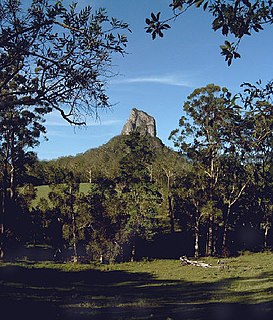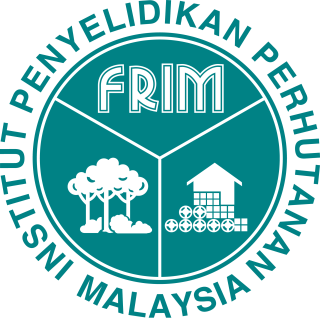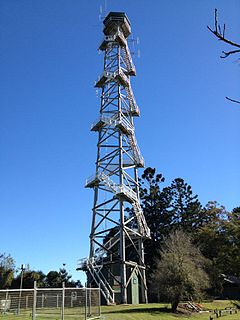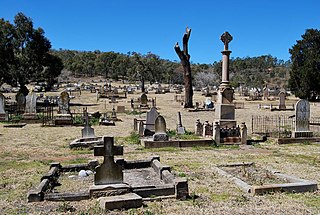
Glass House Mountains National Park is a heritage-listed national park at Glass House Mountains, Sunshine Coast Region, Queensland, Australia. It is also known as Beerburrum Forest Reserve 1. It is 70 km (43 mi) north of Brisbane and consists of a flat plain punctuated by rhyolite and trachyte volcanic plugs, the cores of extinct volcanoes that formed 27 million to 26 million years ago. The mountains would once have had pyroclastic exteriors, but these have eroded away.

An arboretum in a general sense is a botanical collection composed exclusively of trees. More commonly a modern arboretum is a botanical garden containing living collections of woody plants and is intended at least in part for scientific study.

The Big Pineapple is a heritage-listed tourist attraction at Nambour Connection Road, Woombye, Sunshine Coast Region, Queensland, Australia. It was designed by Peddle Thorp and Harvey, Paul Luff, and Gary Smallcombe and Associates. It is also known as Sunshine Plantation. It was added to the Queensland Heritage Register on 6 March 2009.

The Cornell Botanic Gardens, formerly known as the Cornell Plantations, is a botanical garden located adjacent to the Cornell University campus in Ithaca, New York. The Botanic Gardens proper consist of 25 acres (10 ha) of botanical gardens and 150 acres (61 ha) of the F.R. Newman Arboretum. The greater Botanic Gardens includes 40 different nature areas around Cornell and Ithaca, covering 4,300 acres (1,700 ha).

The Forest Research Institute Malaysia is a statutory agency of the Government of Malaysia, under the Ministry of Land, Water and Natural Resources (KATS). FRIM promotes sustainable management and optimal use of forest resources in Malaysia by generating knowledge and technology through research, development and application in tropical forestry. FRIM is located in Kepong, near Kuala Lumpur.

Beerburrum is a small town and coastal locality in the Sunshine Coast Region, Queensland, Australia. In the 2016 census, Beerburrum had a population of 763 people.

Pechey is a small rural locality in the Toowoomba Region, Queensland, Australia.

Swain House is a heritage-listed detached house at 139 Laurel Avenue, Chelmer, City of Brisbane, Queensland, Australia. It was built from the 1920s onwards. It was added to the Queensland Heritage Register on 12 December 2003.

Sherwood Arboretum is a heritage-listed arboretum at 39A Turner Street, Sherwood, Queensland, Australia. A 1946 addition to the site is also known as the John Herbert Memorial Vista. It was added to the Queensland Heritage Register on 3 May 2007.

Edward Harold Fulcher Swain (1883—1970) was a forester in New South Wales and Queensland, Australia. Swain laid the foundations of modern forestry economics in Queensland.

Jimna Fire Tower is a heritage-listed former fire lookout tower at Jimna State Forest, Murgon-Kilcoy Road, Jimna, Somerset Region, Queensland, Australia. It was designed by Arthur Leis and built from c. 1975 to 1977 by Arthur Leis. It is also known as SEQ-4C 8. It was added to the Queensland Heritage Register on 23 July 1999.

Jimna Single Men's Barracks is a heritage-listed workers' housing at 4 Tip Road, Jimna, Somerset Region, Queensland, Australia. It was built in 1930s. It was added to the Queensland Heritage Register on 27 November 2008.

The Crohamhurst Observatory is a heritage-listed observatory at 131 Crohamhurst Road, Crohamhurst, Sunshine Coast Region, Queensland, Australia. It was built in 1935. It was added to the Queensland Heritage Register on 13 November 2008.

Central Sugar Mill Ruins is a heritage-listed former sugar cane mill at Old Mill Road, Yengarie, Fraser Coast Region, Queensland, Australia. It was built from 1866 to 1890s. It was added to the Queensland Heritage Register on 5 December 2005.

Mount Morgan Cemetery is a heritage-listed cemetery at East Street, Mount Morgan, Rockhampton Region, Queensland, Australia. It was established in 1886. It was added to the Queensland Heritage Register on 21 October 1992.

Cactoblastis Memorial Hall is a heritage-listed memorial at Warrego Highway, Boonarga, Western Downs Region, Queensland, Australia. It was built in 1936 by Jack Schloss. It was added to the Queensland Heritage Register on 21 September 1993.

Branyan Road State School is a heritage-listed state school at Branyan Drive, Branyan, Bundaberg, Bundaberg Region, Queensland, Australia. It was designed by Queensland Department of Public Works and built in 1905. It was added to the Queensland Heritage Register on 1 May 2015.

Marburg State School is a heritage-listed state school at Louisa Street, Marburg, City of Ipswich, Queensland, Australia. It was designed by Queensland Department of Public Works and built in 1922. It is also known as Marburg Rural School. It was added to the Queensland Heritage Register on 9 October 2015.

Waaje Fire Tower No.4 is a heritage-listed fire lookout tower at Barakula State Forest, Barakula, Western Downs Region, Queensland, Australia. It was built in 1964 by Arthur Leis. It was added to the Queensland Heritage Register on 25 January 2018.

The Tokai Arboretum was the first large-scale silviculture experimental station in Cape Town, South Africa. The area of the main Arboretum, at Tokai Park, is 14 ha. Several adjacent compartments extend the area to 26 ha. The Arboretum was declared a National Monument in 1985, on its 100th anniversary. It contains stands of Eucalyptus and other trees from the original silviculture experiments in South Africa. In the 1990s a Gondwana Garden was created to display the plants typical of the Cape 100 million years ago.






















